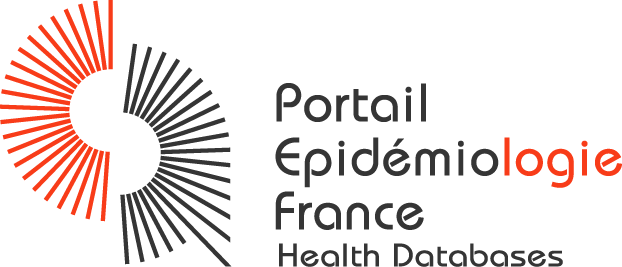 ITMO Santé Publique
ITMO Santé Publique


Date de modification : 01/01/2019 | Version : 1 | ID : 73176
| Général | |
| Identification | |
| Nom détaillé | National survey on serious adverse events in hospitals |
| Sigle ou acronyme | ENEIS |
| Numéro d'enregistrement (ID-RCB ou EUDRACT, CNIL, CPP, etc.) | Cnil : 1328615 ; CNIS : label n°2009X706SA Thématiques générales |
| Thématiques générales | |
| Domaine médical |
Study of allergies |
| Déterminants de santé |
Iatrogenic Medicine |
| Mots-clés | serious adverse events, patient safety |
| Responsable(s) scientifique(s) | |
| Nom du responsable | Michel |
| Prénom | Philippe |
| Adresse |
3 Quai des Célestins 69002 Lyon |
| Téléphone | +33 (0)4 72 40 71 04 |
| philippe.michel@chu-lyon.fr | |
| Organisme | Hospices Civils de Lyon |
| Collaborations | |
| Financements | |
| Financements |
Public |
| Précisions | Ministère de la santé - DREES |
| Gouvernance de la base de données | |
| Organisation(s) responsable(s) ou promoteur | Direction de la recherche, des études, de l'évaluation et des statistiques (DREES) |
| Statut de l’organisation |
Secteur Public |
| Contact(s) supplémentaire(s) | |
| Caractéristiques | |
| Type de base de données | |
| Type de base de données |
Study databases |
| Base de données issues d'enquêtes, précisions |
Repeated cross-sectional studies (except case control studies) |
| Origine du recrutement des participants |
A selection of health institutions and services |
| Le recrutement dans la base de données s'effectue dans le cadre d'une étude interventionnelle |
No |
| Informations complémentaires concernant la constitution de l'échantillon | Sampling plan: Three-tier sampling 1st tier: picking of observation dates (window of observation) 2nd tier: picking of beds 3nd tier: picking of stays or fractions of stays observed over the period of observation. |
| Objectif de la base de données | |
| Objectif principal |
The survey's primary objective is to estimate the incidence of serious adverse events observed in hospitals and their avoidable character - for events resulting from admission in medicine and surgery units of health institutions or arising in such units during hospitalization.
The secondary objectives are: 1) estimate the severity and avoidable portion of such events; 2) describe the immediate care-related causes of such events arising. |
| Critères d'inclusion | All patient stays present during the survey in shortstay medicine and surgery units |
| Type de population | |
| Age |
Newborns (birth to 28 days) Infant (28 days to 2 years) Early childhood (2 to 5 years) Childhood (6 to 13 years) Adolescence (13 to 18 years) Adulthood (19 to 24 years) Adulthood (25 to 44 years) Adulthood (45 to 64 years) Elderly (65 to 79 years) Great age (80 years and more) |
| Population concernée |
Sick population |
| Sexe |
Male Woman |
| Champ géographique |
National |
| Détail du champ géographique | Metropolitan France |
| Collecte | |
| Dates | |
| Année du premier recueil | 2004 |
| Année du dernier recueil | 2009 |
| Taille de la base de données | |
| Taille de la base de données (en nombre d'individus) |
[1000-10 000[ individuals |
| Détail du nombre d'individus | The purpose is to compile a minimum sample of 800 stays or fractions of stays in each of the analytical areas defined below. The analysis is conducted according to two main criteria: 1) the type of care unit: surgery or medicine 2) the type of care institution: regional or university teaching hospitals (CHU/CHR), other public and private not-for-profit institutions, private profitmaking institutions. This makes six analytical strata. In total, around 8,000 stays make up the sample. The sample allows for national estimations to be made. |
| Données | |
| Activité de la base |
Data collection completed |
| Type de données recueillies |
Clinical data Administrative data |
| Données cliniques, précisions |
Direct physical measures |
| Données administratives, précisions | admission date, discharge date, age |
| Existence d’une biothèque |
No |
| Paramètres de santé étudiés |
Health event/morbidity Health event/mortality |
| Modalités | |
| Mode de recueil des données | External survey takers to the health institution collected the data over two stages During one week, an investigating nurse comes every two or three days to detect patients likely to present an adverse event from a grid of 17 detection criteria. This detection is carried out with the care manager and on the basis of the patient's record. One or two weeks afterwards, an investigating physician comes to the unit to confirm or invalidate the presence of an adverse event for the patients detected. Moreover, this physician assesses the avoidable character of the events that have occurred during hospitalization. To do this, s/he meets the patient's attending physician, with whom s/he also consults the patient's record. |
| Suivi des participants |
No |
| Appariement avec des sources administratives |
No |
| Valorisation et accès | |
| Valorisation et accès | |
| Lien vers le document | http://www.drees.sante.gouv.fr/l-enquete-nationale-sur-les-evenements-indesirables-lies,6507.html |
| Accès | |
| Charte d'accès aux données (convention de mise à disposition, format de données et délais de mise à disposition) |
The anonymized database can be made available to researchers subject to a justified request (examination by a scientific committee).
The participating institutions are given feedback concerning them in December of the collection year. |
| Accès aux données agrégées |
Access on specific project only |
| Accès aux données individuelles |
Access on specific project only |
Partenaires - F.A.Q. - Contact - Plan du site - Mentions légales - Administration - PEF-HD - Mis à jour le 15 décembre 2020 - Version 4.10.05